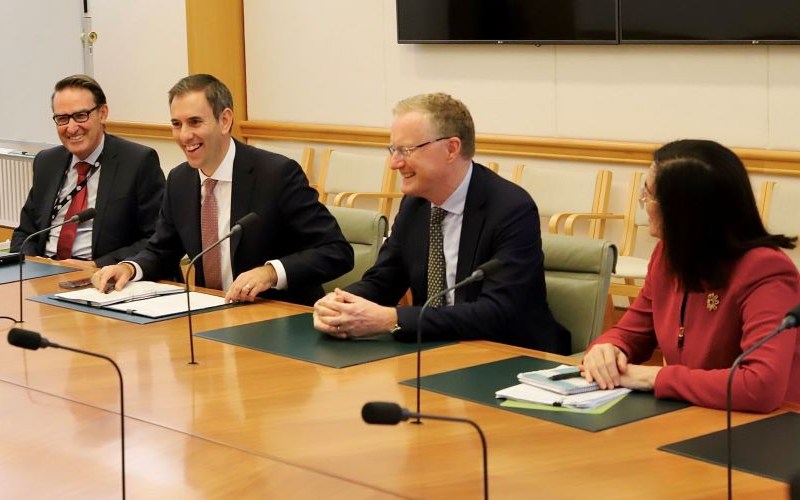Review items include scrutinising who sits on the RBA Board, and if views should be more transparent.
The review will also assess "the appropriateness of the inflation targeting framework".
This comes ahead of Dr Philip Lowe's scheduled exit as RBA Governor from September 2023.
Speaking to ABC News, Dr Chalmers says this isn't to take "pot shots at the Reserve Bank or its Governor".
"My job as the Treasurer is to make sure we give them the best set of institutional arrangements so they can make the right decisions into the future," he said.
The RBA is one of the few advanced economies' central banks to not have gone through a review this century.
Dr Chalmers said part of the justification for this review was to help the RBA get economic forecasts right.
"Part of doing (this) is to make sure they have the right kind of institution that gives them the best chance to get the forecast right, to get the decisions right," Dr Chalmers told the Nine Network.
In a speech to the Australian Strategic Business forum today, Governor Lowe welcomed the review.
"It is an opportunity to take stock of our monetary policy arrangements and make sure that they are fit for purpose for the challenges ahead," he said.
The @RBAinfo Review I announced today is all about renewing, revitalising and building confidence in the Reserve Bank. #auspol #ausecon pic.twitter.com/3e0fjeb1I7
— Jim Chalmers MP (@JEChalmers) July 19, 2022
RBA forecasts have significantly undercooked key economic markers, and the RBA missed its underlying inflation target of 2-3% for around six years until the recent run-up of inflation.
As recently as March, the topline message from the RBA was that there is unlikely to be any cash rate increase until 2024.
Governor Dr Philip Lowe also previously ruled out a 2022 increase in the cash rate, though it is unclear how other Board members felt.
"We can be patient in a way that countries with substantially higher rates of inflation cannot," Dr Lowe said in March.
Shortly after, inflation rose to its highest levels since the 1990s, forecast to hit 7% by year's end.
In February, CBA's head of Australian economics Gareth Aird was critical of the RBA's stance on inflation.
"[RBA economists] went out of their way to argue why the inflation dynamics would be different in Australia compared to many other comparable countries where inflation has risen significantly," Mr Aird said.
In Board meeting minutes released yesterday, members agreed that much of the inflation was internationally-led.
"The continuing fallout from Russia's invasion of Ukraine was evident in increases in the prices of fuel, electricity and food in many economies, which had boosted headline inflation in May and June," the minutes read.
"Crude oil prices were below their peaks earlier in the year but remained high, while gas prices in Europe and Asia had increased further."
In an interview with the ABC's 7.30, Dr Lowe admitted the RBA may have suffered some reputational damage as a result of its flip-flop in policy.
Should the Reserve Bank be more transparent?
Unlike the United States' and the United Kingdom's central banks, Australia's Reserve Bank does not publicly disclose Board members' votes on monetary policy.
In a rare exit speech, Bank of England monetary policy committee (MPC) member Michael Saunders said public voting information is a favoured level of transparency.
"Credibility would be eroded if central bankers disagree in private on the appropriate policy stance but feel they should hide such disagreements to give a false public appearance of unanimity," Mr Saunders said.
Data shows Bank of England Board members dissent at a rate slightly higher than other countries with publicly-available dissenting information.
However, it remains quite low - since mid-1997 roughly one-in-eight votes dissented on the majority.
"I regard the MPC’s current system - individual votes that are publicly disclosed - as greatly superior to the main alternatives: single decision-maker; a Committee with votes in private but not publicly disclosed; or a consensus-based approach," Mr Saunders said.
Westpac chief economist Bill Evans said the RBA began to publicly announce cash rate decisions only in 1990.
"It has never raised the cash rate in two consecutive meetings by 50 basis points each," Mr Evans said.
"However, the Governor’s statement [on 5 July] made no reference to that historical precedent, something that may have been done if he was signalling the intention to scale back the moves.
"Neither did he assess that the stance of policy had moved from stimulatory to the neutral range."
A neutral rate refers to a cash rate that is neither stimulatory or contractionary for the economy.
Previously neutral was thought to be in the mid-2% range however now it is unclear what 'neutral' means, and is a term that Board members said evolves over time.
"In recent decades, estimates of the neutral rate have drifted lower in major advanced economies and in Australia," Board minutes read.
ANZ bank economists forecast the cash rate to hit 3% by year's end, while CBA economists forecast 2.60%.
Westpac economists have it pegged at 2.35% in December - "firmly in contractionary territory".
Image: Dr Jim Chalmers and Dr Philip Lowe (centre left and right) in May, via @JEChalmers Twitter.

Ready, Set, Buy!
Learn everything you need to know about buying property – from choosing the right property and home loan, to the purchasing process, tips to save money and more!
With bonus Q&A sheet and Crossword!

.jpg)